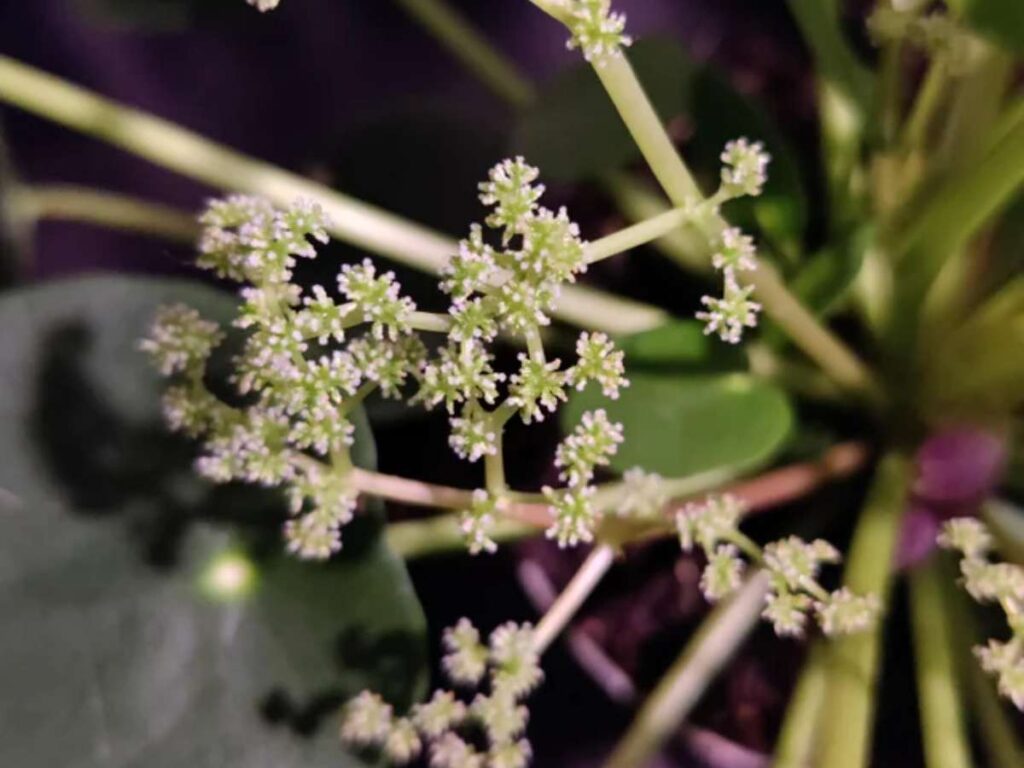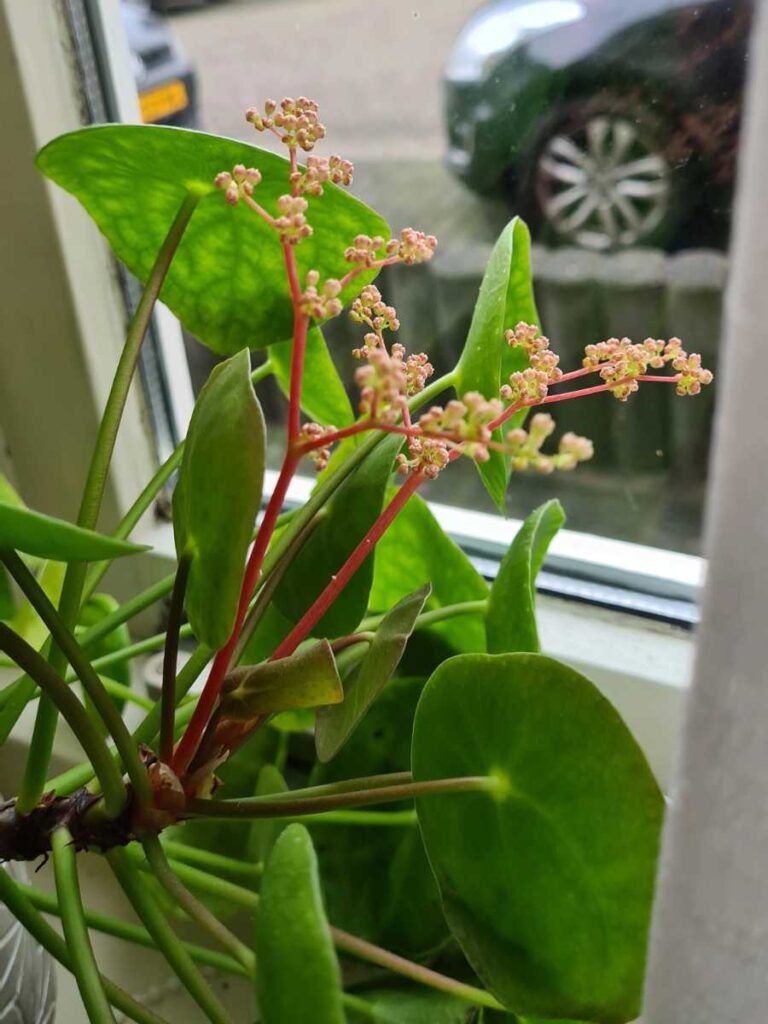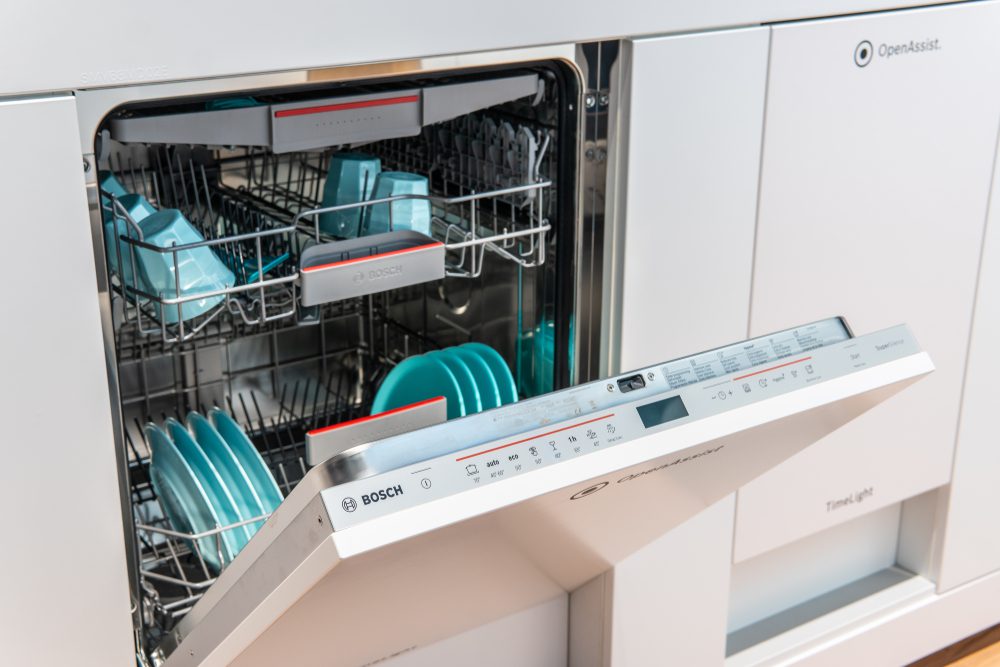The Chinese money plant, also known as the Pilea peperomioides, is a symbol of luck and prosperity. It has been used for centuries by those seeking good fortune in their lives.
But did you know that this humble houseplant can also produce beautiful flowers?
This article will explore the mysteries behind these remarkable plants, uncovering whether they really have blooms.
Here’s Do Chinese Money Plants Have Flowers?
Chinese money plants (Pilea peperomioides) may produce small, insignificant pink flowers in the winter under cool conditions. The buds are bright green when they first start coming out from the tip of the stem and can turn white or pale as they open.

Why Is My Chinese Money Plant Growing Flowers?
We’ve all been there: you take home your new Chinese money plant, excitedly potting it and giving it just the right amount of water. You love its attractive leaves and admire them every day – until one day when something strange happens. Your beloved UFO-shaped plant starts to produce flowers! But why?
The answer may lie in how you’re caring for your Chinese money plant. For example, it’s possible that too much sunlight or warmth is encouraging flowering; as a result, the plant may be trying to reproduce itself by setting a seed. Alternatively, if your soil has lots of nutrients like nitrogen, this can also stimulate bloom.
It could also be down to genetics – some varieties of Chinese Money Plant naturally flower more than others, so what you’re seeing might be the natural cycle of your particular specimen.
Whatever the reason, blooming isn’t necessarily a bad thing; with proper care and attention from you, these delicate little flowers will make an already beautiful addition to your home even lovelier!
Is It Rare for Pilea Peperomioides to Bloom?
It is rare for Pilea Peperomioides to bloom. The plant has a higher chance of blooming in its natural habitat, but it does not happen very often. When it does, the flowers are whitish-pink and very tiny.
The story of a pilea blooming is like that of a butterfly emerging from its chrysalis: it takes time, patience, and nurturing to get there. But when the wait is over, you are rewarded with an ethereal beauty that can be seen nowhere else.
When caring for your new plant friend, here are three things to consider for successful flowering: drainage hole, soil type, and watering frequency.
It’s important to make sure that the pot has suitable drainage holes, so excess water isn’t trapped in the soil – this can lead to root rot or other problems down the line.
Secondly, as heavier soils, lightweight soil may need to provide more oxygen for healthy root growth.
Finally, keep track of how often you’re watering – too much or too little could mean disaster!
If all conditions have been met and your pilea is still not blooming, then don’t worry – sometimes it just needs more time. Rest assured that if you give your beloved plant plenty of love and attention, then eventually, you will see those beautiful flowers bloom under your watchful eye.
What Does a Money Flower Look Like?
Money flowers are unique in their appearance and structure. They look like tiny umbrellas with delicate white petals adorning them – almost like snowflakes on a winter day. The petals are thin yet sturdy enough to last through rainstorms and heat waves.
For extra charm, some varieties have yellow centers which stand out against the backdrop of white petals. It’s no wonder why so many people find money flowers captivating!
But beauty isn’t all this new plant has to go for it; it also produces seeds as part of its natural lifecycle. These can be planted in soil or water once fully mature, giving homeowners an easy way to propagate their money flower at home if desired.
So not only does this exciting species bring visual delight, but practicality too!
If you’re looking for something special that adds both decorative flair and long-term rewards to your garden or living space, then money flowers could be just what you need.
Whether placed indoors or outdoors, they’ll always manage to draw attention while providing plenty of color throughout each season. All in all, a great addition to any green thumb’s collection!

How Do I Get My Money Plant to Flower?
It’s often said that growing a money plant is like watching your own little bank balance grow. This is more than just metaphorically true, as many people have successfully managed to get their pilea plants to flower and produce seeds for replanting. But how do you go about getting the most out of this process?
For one thing, regular attention to detail is key. In addition, money plants need plenty of light and consistent watering – don’t let them become too dry or overwatered!
For another, they should be kept away from extreme temperatures – so if it’s particularly cold outside, keep them indoors instead.
And finally, make sure to feed them with a liquid fertilizer every month or two during the summer months when growth is at its peak.
These simple steps will help ensure optimal conditions for flowering and seed production in your money plant: patience, consistency, and care are all important factors here.
Why Do People Want Flowers on Their Chinese Money Plants?
It’s natural for people to want flowers on their plants, and Chinese money plants are no exception. It can be a beautiful sight to see the unique five-petal bloom of a Chinese money plant in full flower – but unfortunately, it is not something that happens often. So why do we have such an affinity with these rare blooms?
There may be many reasons why people get excited when they spot a flowering Chinese money plant. For some, it is the beauty of seeing something unexpected; this type of plant is usually known for its distinct foliage rather than its flowers.
But others might view it as a sign of luck or prosperity – much like other houseplants, which are popularly believed to bring good fortune into our homes.
Whatever the reason, there’s no denying that having a flowering Chinese money plant brings joy to those lucky enough to witness one. The event’s rarity makes it even more special, adding an extra layer of excitement and intrigue for those who care for them.
Can I Force My Pilea to Bloom?
It’s estimated that around 1 in 4 house plants are bought to improve mental well-being. If you’re looking to do this too, a Chinese Money Plant or Pilea peperomioides is a great choice!
Let’s explore what it takes for your Pilea to flower:
How long does it take for one to flower?
Generally speaking, if given optimum conditions and care, it can take from 3 months to 2 years before seeing any flowers on your plant.
What else must be taken into consideration?
There are many things needed for successful flowering, such as temperature, humidity levels, age and size of the plant, soil quality, water intake, and much more!
Are there any other ways to encourage blooming?
Although there are no guaranteed methods of getting your plants to bloom quicker, there are some tips you can try. For instance, you can use liquid fertilizer such as seaweed extract every two weeks during the warmer months.
Pinching off new growth at the top will also help promote side branching, which may lead to blooms.
With so much effort required in order for your Pilea peperomioides to show its full potential – patience is key! But, with enough TLC, you’ll soon have an array of beautiful pink/white flowers bursting through, allowing you ample opportunity to Instagram those insta worthy shots!
Should I Remove the Blooms?
First off, the beauty of having flowers on your pilea is undeniable. That said, once they’ve bloomed and died back naturally, they can be unsightly and take away from the overall look of the plant. So if that’s what you see with yours, then removing them may be an option.
On the other hand, leaving them in place has some advantages too. For example, dead flower heads provide valuable information about how much sunlight or water your Pilea needs – plus, they also add texture and interest to your display!
So before deciding whether or not to remove them entirely, think carefully about the effect, their presence will have on the appearance of your home.
Ultimately, only you know what looks best in your space – so make sure whatever decision you choose fits in with your own style and aesthetic goals.
What Happens when The Blooms Are Spent?
As the flowers age, they drop their petals one by one until all that’s left is an empty stem. This can feel like a sad sight as we’re used to seeing plants in full bloom. However, this doesn’t mean the end of your money plant; it’s simply getting ready for the next growth cycle.
Once the old blossoms have dropped away, new buds will form at the base of each branch – a sign that a fresh crop of flowers is on its way! With proper care and attention, these will soon be followed by lush foliage and more striking blooms than ever before.
So don’t despair: what looks like fading beauty maybe just a stage before something lovelier appears!
Is It Lucky for A Chinese Money Plant to Flower?
Some people believe that if your money plants flowers, you’ll be blessed with riches and good fortune. Others see bloomed plants as signs of stress and neglect – so these blooms can symbolize bad luck instead of good. So what do we make of this?
Well, although scientific studies haven’t yet proven either theory right or wrong on the matter of ‘lucky flowers,’ many people have their own opinion on how they should interpret them.
Some think that while having a flower-bearing money tree may mean more work caring for the plant afterward, it could also signify growth both literally and metaphorically, showing us that even though life can present challenges, something incredible can come out of it too.
Ultimately, only time will tell just how lucky our beloved money trees really are!
Conclusion
The Chinese money plant is a beautiful, hardy houseplant that adds life to any home or office. While it’s not common for this species of Pilea to flower when they do, the blooms are delicate and attractive.
The lucky owner may even be fortunate enough to have their plant bloom more than once – though understanding how to care for these plants correctly will help ensure a healthy money plant with plenty of flowers in future years.
Take my neighbor as an example: she has been tending her Chinese Money Plant faithfully since day one, and it often produces several small clusters of white flowers during the summer months. She takes extra special care of her beloved pilea by providing ample light, water, and nutrients while regularly pruning away any dead leaves. These efforts seem to be paying off, as the number of blooms increases year after year – much to her delight!
So if you’re considering getting your Chinese money tree but were concerned about its lack of flowering potential, put those worries aside! With proper care and attention, you too can enjoy the beauty of this rare phenomenon – as long as you remember that patience really is key here









